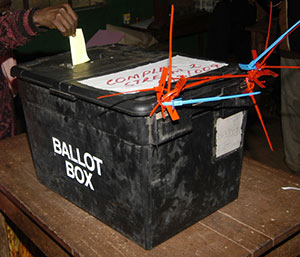14 May 2013, by Seema Shah.

On Saturday, March 30, 2013, the Supreme Court of Kenya issued its ruling in the landmark case upholding the outcome of the recent presidential elections. The court rejected arguments that the electoral process had been rigged and the results should be considered invalid.
It unanimously ruled that the election had been free and fair, in compliance with the Constitution and that Uhuru Kenyatta and William Ruto had been validly elected. It also decided that ‘all votes cast’, i.e. the number representing the total voter turn-out should not have included rejected votes. Acknowledging these votes increases the official total of votes cast and as a result raises the number of votes needed to cross the 50 per cent threshold and win.
The court ruling was in response to three separate petitions, including one from the Africa Centre for Open Governance (AfriCOG).
The AfriCOG petition claimed that the “election process was irredeemably flawed and the results should be nullified”. The petition asked that the Supreme Court look at whether the election complied with the Constitution of Kenya as well as with the accompanying new election laws and regulations.
The Constitution provides that elections must be held in a manner that is “free, fair, transparent, simple, accurate and verifiable”.[1] The Elections Act provides more specifics, demanding that a Principal Register of Voters be published before the election to realise transparency. The IEBC (Independent Electoral and Boundaries Commission) used multiple registers in the 4 March 2013 General Election which left a lot of room for manipulation.
In fact, there appear to have been at least six different registers used during various parts of the electoral process. According to the IEBC, one register known as the ‘Green Book’ contained the complete list of registered voters and should therefore correspond with the number of registered voters announced by the IEBC on 9 March. However, out of the 22 polling stations reviewed by the Court, the number in the Green Book only corresponded with the IEBC number from one polling station.
In previous elections, including in 2007, the opaqueness of the voters’ register allowed for the manipulation of the votes. The Principal Register of Voters was established before this latest election to enable public scrutiny of the numbers and reduce opportunities for meddling with the votes. The impact of the lack of a finalised register can be seen from the multiple instances where voter turnout exceeded 100 per cent. AfriCOG’s interim analysis, which only covers a fraction of the Kenyan constituencies, found that at least 29 polling stations had an over 100 per cent turnout. The data collected and analysed by the Supreme Court, which included, among other things, an in-depth scrutiny of 22 polling stations and constituency level tallying forms, showed at least 16 instances where the voter turnout was over 100 per cent.[2] How can the official results be credible in the context of such findings?
The use of multiple registers violates the Constitution and the law. While it can be expected that the register will shrink, due to ineligible voters being weeded out, what is inexplicable is additions to the register. How can voters be added after the close of the register? The constituency of Turkana Central is a striking example of this – 8,516 voters were added to the register after its registration closed.[3] This was the largest addition rate in the country.[4]
The IEBC also failed to comply with the laws and regulations demanding electronic transmission of results from polling centres to the national tallying centre. The electronic transmission was intended to ensure transparency, accuracy, credibility and verifiability of the vote, as required by the Constitution. The failure of this system left no checks on the manual count. In fact, AfriCOG’s analysis shows discrepancies between the results as reported at the polling station level and the electronically transmitted results for at least 3 out of the 8 presidential candidates. The recourse to manual tallying undermined the Kenyans’ desire for a credible and transparent election.
The Supreme Court ruling was striking, not just for what it did say but perhaps especially so for what it did not mention. The Court’s failure to, at the very least, admonish the IEBC for its multiple process errors and general opacity implies an affirmation of, at best, a poorly conducted election held to disappointingly low standards. As shown above, there is copious evidence of these failures, much of which remains unexplained even after the release of the detailed judgment.
The real losers in all this are the Kenyan people, who are left with no way to resolve all the inconsistencies and with little hope that anything will improve in the future. After all, the IEBC walked away without having to even acknowledge its many errors; its failures having been implicitly deemed acceptable by the Court. The Supreme Court is the final authority on this issue; no appeal is possible. It is left now to the Kenyan people to look at the evidence and attempt to draw their own conclusions. Their response will be a testament to the strength of Kenyan democracy.
About Dr. Seema Shah
Dr. Seema Shah is a political scientist, who examines public policy issues for the Africa Centre for Open Governance in Kenya. Her focus is on elections and ethnic violence.
- Constitution of Kenya, 86 (a)
- See AfriCOG’s analysis
- Ibid.
- A comparison of the provisional register, published in December 2012 and the gazetted register, published in February 2013, shows that changes were made to each and every constituency.



